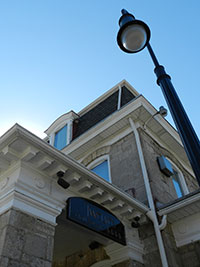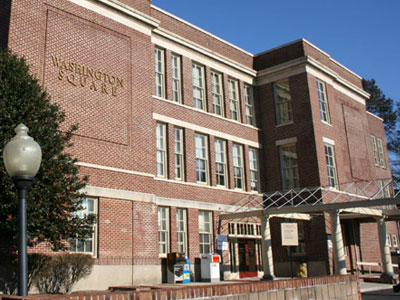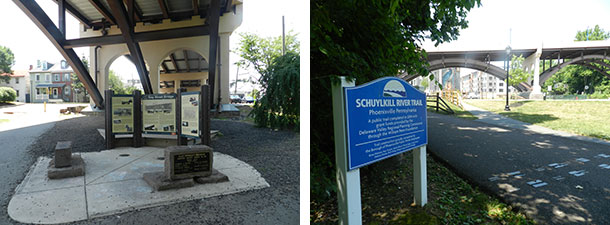Getting Started
While each project is unique, some basic steps are common to adaptive reuse projects. Successful projects depend on cooperation between municipalities and developers and meeting each party's goals. Basic front-end steps apply to reuse projects, which can vary from other development projects. Proper planning in the early stages of an adaptive reuse project should help to mitigate problems during implementation.
Proper planning in the early stages of an adaptive reuse project should help to mitigate problems during implementation.
Project Initiation
Adaptive reuse projects can be individual or collaborative efforts involving any combination of developers, corporations, owners, public entities, or non-profits. Projects can expand development opportunities, maximize a building's potential, preservation, and economic revitalization, meet the demand for unique space, protect/maximize an investment, or address a community need. During project initiation, a preliminary overview of existing conditions and local controls may occur to assess reuse alternatives for a building.
Projects initiated by public entities or nonprofits are generally undertaken with community goals or needs in mind. Non-profits can often serve as go-betweens with various participating entities and can spur community support and assistance. Public entities can encourage reuse through a variety of ways that include, but are not limited to zoning, building codes applicable to existing buildings, property tax abatements, reuse/redevelopment planning and studies, funding assistance, infrastructure upgrades, environmental mitigation, and by selling or leasing publicly owned buildings for a nominal amount to those who propose reuse, or undertaking reuse for a public purpose.

Architectural features are prominent on the exterior of the Twelves Café in West Grove Borough.
Project Feasibility
When conducting a project feasibility study local market and economic conditions, location and site, structural and architectural/historical considerations, and local controls are all evaluated. Additionally, conceptual plans are prepared, and cost estimates are determined. Using this information along with an economic feasibility study suitable reuse alternatives are identified. Unlike new developments, the building, location, and local market are already established in reuse projects. Successful adaptive reuses are responsive to local market demands and integrate location and building characteristics with identified demands. Evaluating the market includes examining what types of uses can be supported by the local market and the level of realistic demand for uses at an existing location. Demographic patterns, local characteristics, recent development trends, and competitors are analyzed, and unique market opportunities are identified. Locational and site considerations are important and include access, parking, nearby uses, current public and private activities, and availability of community services and facilities.
Building Evaluation
Structural integrity and stability are inspected to evaluate a building's physical condition and adaptability for new uses. Specifically, layout, structural capacity, possible contaminants, mechanical and electrical systems, infrastructure, architectural and historic features, code issues, as well as the cost to upgrade are all analyzed. Where multiple buildings exist on a site, the cost of demolition may become a factor. If a building is designated as architecturally or historically significant, design review at the local [municipal], state, or national levels may be necessary. For publicly owned buildings, some of these factors may have previously been examined or determined. At this stage, a building program delineating the physical requirements of the project is developed.
If a building is designated as architecturally or historically significant, design review at the local [municipal], state, or national levels may be necessary.
Local Controls
Local controls are evaluated to determine the regulatory compliance needed. These may include zoning, building codes, design guidelines within established historic districts, and the compatibility of reuse with these controls. A municipality may examine local ordinances and building codes to determine if an adaptive reuse project can happen. Revisions to codes and ordinances may be necessary to allow the reuse of existing buildings. Public sector participation through providing staff support, supplying demographic and economic information, serving as a point of contact with community groups, and providing incentives to encourage reuse, e.g., helping fund or conduct feasibility studies.
Plans and Work Schedule
Conceptual architectural plans and an outline description of the work are prepared incorporating program, locational, physical, and code information. Working with existing building features (which give a building its identity and can be a marketing asset), maximizes usable space to increase revenue potential are important considerations in design development. Cost estimates are a necessary component for completing a financial analysis. Based on conceptual plans, a rough order of magnitude cost estimate can be used to estimate project costs.
A work schedule is only speculative until an end user is identified. The type of end user will determine the need for upgrades to existing infrastructure. For example, an upgrade to plumbing, electric wiring, and insulation would be necessary to convert a box store to a retirement home or apartments. A work schedule is only a projection as issues may develop during the construction phase that could delay the completion of an adaptive reuse.

In addition to preserving an historic resource, Anchor Fitness also serves a community need for a neighborhood fitness center./p>
Financial Plan
Financial considerations are important to acquisition, building conversion, and the economic viability of an adaptive reuse project and are involved throughout the process. A detailed financial analysis should be completed to examine conceptual design/plans, economic feasibility, and securing financing. To complete a financial feasibility analysis financing sources and public financial incentives should be investigated, project costs estimated, and funding generated. Project costs vary but include acquisition, construction, indirect costs such as professional and permit fees, financing costs, fixed costs such as taxes (frequently the largest single cost), and insurance. Factors that will affect cost can include infrastructure upgrades, meeting codes, and demolition of any extraneous buildings on a site. Key considerations in securing financing are ensuring a plan's economic feasibility and meeting necessary public approvals.
Larger adaptive reuse projects are generally financed by a consortium of investors who take advantage of tax credits, or private sources, who also leverage funding, and tax credits. Securing project financing is often one of the most challenging steps and a key roadblock to project implementation, because of factors unique to the nature of reuse projects. These could include higher risk levels assigned, market uncertainties associated with reuse development, and financing largely based on equity. Public involvement can assist financing through direct grants or low-interest loans, site or infrastructure improvements, and tax incentives, among others. In the case of publicly owned buildings, techniques such as long-term leases or other financial strategies may be used.
Potential Funding
Additional Municipal grant opportunities are located on the Municipal Corner section of the Chester County Planning Commission website.
U.S. Department of Housing and Urban Development (HUD) Programs
HUD programs reinforce several important values and principles of community development:
- Flexibility empowers people and communities to design and implement strategies tailored to their needs and priorities.
- Emphasis on consolidated planning expands and strengthens partnerships among all levels of government and the private sector in the development of affordable housing.
- Technical assistance activities and set-aside for qualified community-based nonprofit housing groups build the capacity of these partners.
Community Development Block Grant (CDBG)
CDBG Funding can be used for projects, including reuses, which contribute to revitalization and community development. Visit their website for more information.
Home Investment Partnership Act (HOME)
Home promotes the development of affordable rental housing, which can occur through rehabilitation or reuse, and funding is in the form of "equity investments" and loans. Visit their website for more information.
Funding Sources for Select Projects
Since the passage of federal legislation, The Historic Preservation Act of 1966, standards and tools related to the identification and preservation of historic sites and structures have been established at all levels of government. Today, historic preservation is one more tool for adaptive reuse. There are tax credits and grant funding available if an adaptive reuse project, regardless of the scale, includes a component that meets the fund source's criteria for historic preservation. A criterion through most of these fund sources is that the property needs to be listed on, or is eligible for, the National Register of Historic Places.
Save America's Treasures
This federal grant program, established in 1998 and administered by the National Park Service, is specific to sites and structures classified as:
- Nationally significant as per their National Register of Historic Places listing or;
- Is designated a National Historic Landmark or;
- Listed individually or contributing to a nationally significant district.
Projects funded through this program include:
- Park Inn Hotel, Mason City, Iowa — Historic hotel designed by Frank Lloyd Wright.
- Christ Church Lutheran, Minneapolis, MN — The church was designed by international architect Eliel Saarinen.
- Historic Wayneborough, Paoli, PA — Home of Revolutionary War Major General Anthony Wayne. Grant contributed funds to replace the roof of the historic home.
More information about the program can be found at the National Park Service's website.
Federal Rehabilitation Investment Tax Credit (RITC)

The Washingtown Square Apartments were adaptively-reused with funding, in part, through Federal Rehabilitation Tax Credits.
This tax credit, for eligible projects, applies to certain expenses when restoring a structure. As with other tax credit programs, the structure must be on, or eligible for, the National Register of Historic Places. It requires a multi-part application process.
"A 20% income tax credit is available for the rehabilitation of historic buildings determined by the Secretary of the Interior, through the National Park Service, to be 'certified historic structures.' The buildings must be considered depreciable under the Internal Revenue Code, such as in a business, commercial, or other income-producing use. The State Historic Preservation Offices and the National Park Service review the rehabilitation work to ensure it complies with the Secretary's Standards for Rehabilitation. The Internal Revenue Service defines qualified rehabilitation expenses where credit may be taken. Owner-occupied residential properties do not qualify for the federal rehabilitation tax credit."
Information on eligibility and applying for the tax credit program is available online.
PA Historic Preservation Tax Credit Program (HPTC)
This tax credit program is offered through Pennsylvania's Department of Community and Economic Development. According to the HPTC website, tax credits are eligible to "…qualified taxpayers who will be completing the restoration of a qualified historic structure into an income-producing property. All projects must include a qualified rehabilitation plan approved by the Pennsylvania Historical and Museum Commission (PHMC) as being consistent with the standards for rehabilitation of historic buildings as adopted by the United States Secretary of the Interior."
A qualified taxpayer may apply to the program. The credits available shall:
- Not exceed 25% of the qualified expenditures with the completed project
- The credit may be up to 30% of qualified expenditures in connection with a workforce housing completed project.
Projects approved in the 2023-24 grant cycle did not include any from Chester County. Projects approved in Philadelphia include the Man Full of Trouble Tavern and the Historic Crozer Medical Building on Chestnut Street.
Eligibility requirements, application, and instructions are available online.
Pre-Construction Phase
Once a project is determined feasible and financing is obtained, construction documents are prepared, public approvals are obtained, and the building and potential tenants are secured. Fine-tuning of cost estimates are done to meet the financial needs of the developer. Plans are submitted to public agencies for approval and permitting. Public entities may also be involved through agreements to conduct site or infrastructure upgrades, grants, loans, tax incentives, or to provide long-term leases.

The Foundry is a successful adaptive reuse in Phoenixville that is located in close proximity to community and regional destinations such as the Historic Gay Street Bridge Kiosk and Schuylkill River Trailhead.
Project Implementation
This step involves physical rehabilitation, management, and marketing of the adaptive reuse project. There are important considerations to consider because they can impact the economic feasibility of a project. Examples are controlling rehabilitation costs, availability of specialized materials, and unforeseen delays that can cause a project to take longer to complete than planned Construction management by qualified professionals can help minimize these concerns, as can a realistic rehabilitation schedule and budget. A reasonable contingency fund and flexibility in design and schedule help navigate unplanned delays and other issues that may emerge.
Planning in the early stages can save costs and make physical rehabilitation run more smoothly. Rehabilitation can take place over a shorter time frame since the building is in place and it can be less expensive than new construction. However, due to the unique nature of reuse projects, comparisons with new construction are generally difficult to project. Unless a public agency is undertaking the project, public involvement may be limited to implementing incentives that may have been agreed on. Such incentives could include upgrading infrastructure, environmental clean-up, or working on building improvements to meet local code or ordinance requirements.


